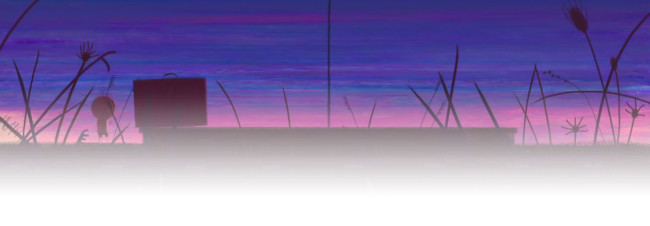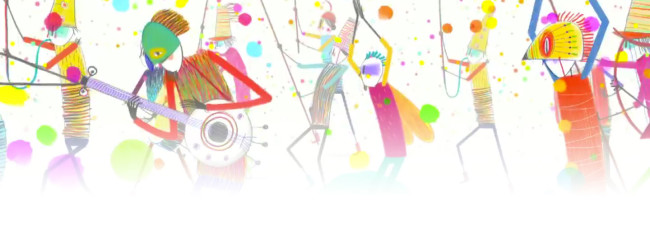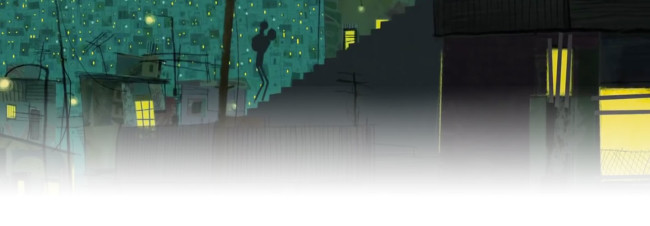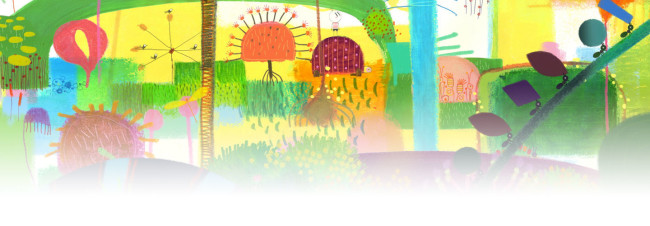A Boy and His Questions
The conclusion of Boy and the World brings us back to Alê Abreu and our world, face to face with a boy and his question. “How long has it been?” the boy asked. “44 years,” Abreu replied, “I’ve been drawing since your age.” It is opening night at the IFC Center theatre in downtown Manhattan, December 11th. The language of the adults in the film is backwards Portuguese. So when the chorus of the movie’s theme song is “airgela,” is means that they are singing “alegria” backwards, translating to “joy.” Following the screening was an appearance by director Alê Abreu, who answered questions via a Portuguese translator.

The iconic birds of Boy and the World were popular with the kids, who wanted to know why the symbolism was so important. “As amazing as it might seem,” Abreu replied, “first I drew what was in my mind, then I tried to find the meaning.” There was a rainbow bird for the protestors, but no bird for the army. “That just didn’t seem fair,” and one thing led to a black bird being born.
In the height of Boy and the World‘s story, the films suddenly breaks away from animation itself. “The film begins with a white sheet of paper,” Abreu explains to the kids, “a metaphysical void.” When we first meet the child, simple shapes and colors are present, with other elements of pencils, watercolor, and collage added as the boy gets closer to the world of men. Abreu broke the movie down into roughly 40 scenes, and assigned each one a color based on the emotions he derived from the scene. “The sacred world” gets covered by clippings, but Abreu found that the collages were not enough, not as intense as he’d like, so the break away from animation represents a breakdown of hope itself. “While I was animating, I was dreaming,” said Abreu, “and it was impossible to dream at that point.”

Abreu spent about 3.5 years ‘dreaming’ in production of Boy and the World. While he had a team of 20 animators, Abreu still says that he is solely responsible for all the animation. He animated the entire film, including backgrounds, and had a crew of around 20 assistant artists/animators and technicians to follow up. It is apparent that much of the film is built around themes of repetition, and elements are copied and reused in patterns that expand the world. One simple green tree can connote vast farms, as the tree is individually painted and duplicated. When they overlap you can see the brush strokes as if Abreu has painted on air instead of paper. There is no script to Boy and the World, just storyboards. In the animatic stage Abreu really began to explore and see how the scenes were connected. When Eric Beckman (founder, GKIDS, distributor) pointed out that almost all animators would not even be able to conceive of animating something without knowing where they were going, Abreu described it as “an unexpected pregnancy.” The film was “fundamentally radical.”
Abreu originally began working on an animated documentary of the history of South/Latin America, when he kept coming across a particular doodle of his in the margins of his notes. It felt like the little boy was waving at him. Eventually, the entire documentary was tabled, and Abreu applied himself to this new animated feature. Boy and the World has a political background, but it was more important to make it an “anti-commercial” film, hence the radical approach to its production.

Boy and the World had a $500,000 budget, and would not have been possible with out extensive government support of the arts. (Children/adults in the audience noticed a large number of logos in the credits.) From the 1990’s on, the National Cinema Agency of Brazil has brought an influx of state and private support to the local film industry. The private companies provide grants, and the grants are distributed by panels of people ‘not from the company,’ as the translator described it. ‘Compare this movie to Song of the Sea‘s $5 million dollar budget, to a Studio Ghibli ‘$50 million’ budget, and to ‘$150 million’ for a Pixar film,’ suggested Eric Beckman to the audience (these are just general estimates, that can be verified or not at the Internet Movie Database).
While the movie represents a dichotomy between simple farm life and modern industrialism, I would not go so far as to say that one is more dystopic or ideal than the other. There are no egregious examples of factory work, and in fact, all of the main characters find their place within the system. The “Jovem” (young man) makes time late at night to weave his own art (which should be familiar to many animators). Many artists and films have covered the struggle between nature and industry (Nausicaa, Wall-E, not to mention many live-action films). But Brazil has only recently modernized its industry and become a “BRIC” force to be reckoned with, and this film can still be considered the opinion of a “third world nation.” Abreu did not start with a message, he started with “feelings that [he] can’t put into words.” Eventually a structure emerges, even if he doesn’t try to understand the scenes at first glance. He arrives at a message at the end of the film, just as the audience does. There is much room for interpretation due to the abstract nature of the film’s chronology, which leads to much discussion about the history of all nations’ development.

“I love to work freely and not let reason and my thought police what I do,” Abreu says. He just puts down colors and lines that he finds beautiful, and has faith that it will all make sense in the end. Boy and the World is Abreu’s 6th film, but the only one that he is “satisfied with.” He wanted to be as close to the boy from the notebooks, so he looked through a child’s eyes. Abreu’s drawings do not look like a child drew them, but he made them with the liberty of a child.
Boy and the World is playing at the IFC now til Dec 17th, and will ‘expand across the country’ in the following weeks.
Run Time: 1 hour 20 minutes





